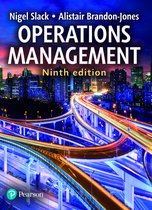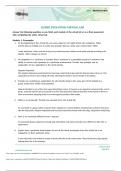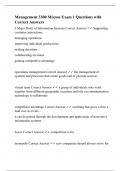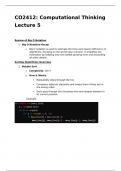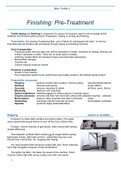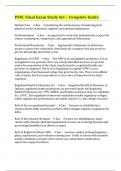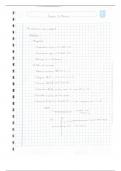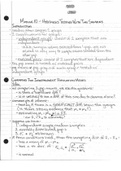Chapter 15 Lean Operations
What is lean?
Lean aims to meet demand for products and services instantaneously, with perfect quality, no waste
and at low cost. It results in materials, information and customers flowing rapidly and smoothly
through processes, operations and supply networks. The central idea is that this not only ensures
reduced throughput time, but also avoids the negative effects of in-process inventory or queues.
Inventories and queues are seen as obscuring the problems that exist within processes and
therefore inhibiting process improvement.
Three perspectives of lean
In many ways, lean can be viewed as three related, but distinct things: a philosophy, a method of
planning and control with useful prescriptions of how to manage day-to-day operations, and a set of
improvement tools:
1. Lean is a philosophy of how to run operations: it is a coherent set of principles that are
founded on smoothing flow through processes by doing all the simple things well, gradually
doing them better, meeting customer needs exactly, and squeezing out waste every step of
the way. Three key issues define the lean philosophy: the involvement of staff in the
operation, the drive for continuous improvement, and the elimination of waste.
2. Lean is a method of planning and controlling operations: many lean ideas are concerned
with how items flow through operations; and more specifically, how operations managers
can manage this flow. Lean planning and control uses several methods to achieve
synchronized flow and reduce waste.
3. Lean is a set of tools that improve operations performance: the ‘engine room’ of the lean
philosophy is a collection of improvement tools and techniques that are the means for
cutting out waste. The rise of lean ideas gave birth to techniques that have now become
mainstream in operations management.
How lean operations considers flow
The traditional approach assumes that each stage in the process will place its output in an inventory
that ‘buffers’ that stage from the next one downstream in the process. These buffers are there to
1
, ‘insulate’ each stage from its neighbors, making each stage relatively independent. This insulation
has to be paid for in terms of inventory or queues and slow throughput times because products,
customers or information will spend time waiting between stages in the process.
In the lean process, products, customers or information are processed and then passed directly to
the next stage in a synchronized manner ‘just-in-time’ for them to be processed further. The aim is
to match demand perfectly. Problems at any stage have a very different effect in such a system.
Exposure of the system to problems can both make them more evident and change the ‘motivation
structure’ of the whole system towards solving the problems. Lean sees accumulations of inventory,
be they product, customer or information inventories, as a ‘blanket of obscurity’ that lies over the
system and prevents problems being noticed.
How lean operations consider inventory
Gradually reducing the inventory exposes the worst of the problems which can be resolved, after
which the inventory is lowered further, exposing more problems and so on. The same argument
applies to the flow between whole processes, or whole operations.
How lean operations considers capacity utilization
Lean has many benefits, but these come at the cost of capacity utilization. High utilization does not
necessarily make the traditional process as a whole deliver more. Often extra ‘production’ goes into
buffer inventories or queues of customers. Any stoppages in a lean process affect the whole process.
Producing just to keep utilization high is not only pointless, it is counter-productive, because the
extra inventory produced merely serves to make improvements less likely.
2
What is lean?
Lean aims to meet demand for products and services instantaneously, with perfect quality, no waste
and at low cost. It results in materials, information and customers flowing rapidly and smoothly
through processes, operations and supply networks. The central idea is that this not only ensures
reduced throughput time, but also avoids the negative effects of in-process inventory or queues.
Inventories and queues are seen as obscuring the problems that exist within processes and
therefore inhibiting process improvement.
Three perspectives of lean
In many ways, lean can be viewed as three related, but distinct things: a philosophy, a method of
planning and control with useful prescriptions of how to manage day-to-day operations, and a set of
improvement tools:
1. Lean is a philosophy of how to run operations: it is a coherent set of principles that are
founded on smoothing flow through processes by doing all the simple things well, gradually
doing them better, meeting customer needs exactly, and squeezing out waste every step of
the way. Three key issues define the lean philosophy: the involvement of staff in the
operation, the drive for continuous improvement, and the elimination of waste.
2. Lean is a method of planning and controlling operations: many lean ideas are concerned
with how items flow through operations; and more specifically, how operations managers
can manage this flow. Lean planning and control uses several methods to achieve
synchronized flow and reduce waste.
3. Lean is a set of tools that improve operations performance: the ‘engine room’ of the lean
philosophy is a collection of improvement tools and techniques that are the means for
cutting out waste. The rise of lean ideas gave birth to techniques that have now become
mainstream in operations management.
How lean operations considers flow
The traditional approach assumes that each stage in the process will place its output in an inventory
that ‘buffers’ that stage from the next one downstream in the process. These buffers are there to
1
, ‘insulate’ each stage from its neighbors, making each stage relatively independent. This insulation
has to be paid for in terms of inventory or queues and slow throughput times because products,
customers or information will spend time waiting between stages in the process.
In the lean process, products, customers or information are processed and then passed directly to
the next stage in a synchronized manner ‘just-in-time’ for them to be processed further. The aim is
to match demand perfectly. Problems at any stage have a very different effect in such a system.
Exposure of the system to problems can both make them more evident and change the ‘motivation
structure’ of the whole system towards solving the problems. Lean sees accumulations of inventory,
be they product, customer or information inventories, as a ‘blanket of obscurity’ that lies over the
system and prevents problems being noticed.
How lean operations consider inventory
Gradually reducing the inventory exposes the worst of the problems which can be resolved, after
which the inventory is lowered further, exposing more problems and so on. The same argument
applies to the flow between whole processes, or whole operations.
How lean operations considers capacity utilization
Lean has many benefits, but these come at the cost of capacity utilization. High utilization does not
necessarily make the traditional process as a whole deliver more. Often extra ‘production’ goes into
buffer inventories or queues of customers. Any stoppages in a lean process affect the whole process.
Producing just to keep utilization high is not only pointless, it is counter-productive, because the
extra inventory produced merely serves to make improvements less likely.
2

